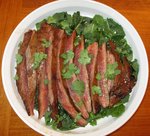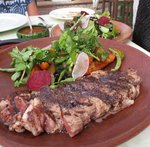Unlike Brazilians and Argentinians, who have been breeding cattle for decades and can appreciate a juicy, tender steak, the people of the Dominican Republic and Mexico tend to cook their beef until …
Stay informed about your community and support local independent journalism.
Subscribe to The River Reporter today. click here
This item is available in full to subscribers.
Please log in to continue |



Unlike Brazilians and Argentinians, who have been breeding cattle for decades and can appreciate a juicy, tender steak, the people of the Dominican Republic and Mexico tend to cook their beef until it is akin to shoe leather. The blood has been sucked out of it; it’s tough, beyond what could be called well-done, and, frankly, an abomination.
The Oaxacans of Mexico know their way around a pig, and it took me until this year to realize that there are a few cuts of beef that they embrace as well. Two of these I fell in love with. A third cut, tasajo, is salted beef round-sliced so thinly that it is impossible to serve rare. However, if cooked briefly, it can be pliant, whereas longer grilling renders it similar to jerky. It, along with its pork counterpart, cecina, is most often served as part of a dish called chilaquiles, eaten for breakfast and sometimes midday. Kids and teens have a special fondness for chilaquiles. It’s easy to prepare, inexpensive and tasty. Basically, it’s a pile of crunchy tortilla chips topped with either a (green) salsa verde or a spicier (red) salsa rojo. This is garnished with a mild, crumbled white cheese and sometimes a drizzle of crema (like liquid sour cream). Some parts of the chip soften under the cloak of sauce and others remain crispy.
The most popular and more sophisticated cuts of beef we enjoyed in Oaxaca are ribeye and arrachera—what Americans call skirt steak. They are different parts of the beast but somewhat similar in heft. They are marinated for tenderness and flavor. Over time, my sister, Janet, and I discovered restaurants, both upscale and more moderately priced places, where these dishes were expertly prepared. The challenge we faced was explaining to the waitstaff how we wanted the chef to prepare our meat. I began each meal, “Por favor. Muy importante, cocinalo muy poco,” roughly translated to “cook it very little.” Finding it difficult to grasp that I meant what I was saying, the waiter would often ask, “Medio?” “No, no, muy, muy rojo,” I would explain. It must’ve sounded strange to hear a customer repeating, “Very, very red!” Sometimes Janet would just let out a “moo!” Eventually, after repeated visits to two favorite eateries, they understood, and would flip their hand over and back quickly to indicate a quick sear on the grill. “Si, si, perfecto!”
We found that ribeye was less dense than arrachera, and even at the finer restaurants it could have fatty channels running through it. The fat was softer than grizzle but inedible pure fat, nonetheless. The rest of the steak would be tender, juicy and so flavorful as to make one swoon. Even better and less costly was the skirt steak. Whatever fat had been in there to begin with had disappeared in the cooking, leaving the meat delicious and without flaw. Again, one could tell it had been lovingly bathed in a marinade, but it was most often difficult to discern what kind. The meat was never spicy nor tasted of one particular ingredient.
When in the mood for meat, we returned to one of the two restaurants where we could count on the kitchen staff, however abhorrent it was to them, to deliver to us exactly what we had requested. The enormous slabs of meat had been allowed to rest briefly to allow the juices to remain intact when cut (against the grain) into thick slices. There was no accompanying sauce or gravy. Just glistening, deeply red, tender meat. Most often, it was served with crisp-skinned seasoned wedges of potato and grilled vegetables such as zucchini, tomatoes, cauliflower, squash and broccoli.
When we returned to the States I found myself hankering for that steak. I have rarely encountered skirt or hanger steak in our local Peck’s supermarket, and when I have, it has been expensive and small in size. Perhaps Carmine’s or Butcher Boys meat shops, both in Sullivan County, sell hunks of skirt, but I’ve never been to either, imagining that a minimum order would be more meat than I know what to do with.
One day, Janet and I were shopping at Aldi’s in Monticello. I was scanning the meat section, which often has such hard-to-find offerings as baby lamb chops and flatiron steaks. There, on a shelf, was a vacuum-packed, thick as could be, enormous slab of skirt steak. I didn’t hesitate. I added it to our shopping cart and headed happily to the cashier.
Once home, I began looking at recipes for arrachera. I knew I wanted to be reminded of those meals in Oaxaca that always started with a strong, salt-rimmed margarita and ended with us staggering back to our hotel, doggy-bag of leftover meat in hand. I don’t recall where I discovered the recipe, but every ingredient rings true to Mexican cuisine down to the Modelo Especial beer in the marinade. Now that grilling season is upon us, throw that bad boy over the coals, but keep a keen eye if you like your meat practically mooing. Otherwise, give it a few more minutes, but don’t invite me over.
Serves 4
1/2 cup diced white onion
2 – 3 garlic cloves, finely minced
Salt
Juice of one lemon
Juice of one lime
Juice of one orange
1/3 cup chopped cilantro
1 teaspoon smoked paprika
1 teaspoon ancho chili powder
1 teaspoon cumin
1 teaspoon Mexican oregano
1 teaspoon freshly ground black pepper
10 ounces Mexican beer, such as Modelo Especial
1 – 1/2 pound skirt (or flank) steak
In a mortar or molcajete, add the garlic and onions. Add 1 teaspoon salt and grind it with the pestle until it becomes like a coarse-looking paste. You can also roughly chop it in an electric mini-chopper or food processor. Transfer the mixture to a medium bowl. Add the remaining ingredients, minus the steak. Stir well to combine. Place the steak in a large zip-lock bag and pour the marinade over it. Seal tightly and let marinate in the fridge for at least 6 hours. When ready to cook, remove the steak from the fridge for 30 minutes to an hour before cooking. Drain off the marinade and transfer steak to a plate. Season with salt. Grill on a stove-top grill or over charcoal for 8 to 10 minutes, turning once or twice. If using a meat thermometer, the steak is rare when it has an internal temperature of 130 degrees.
Let rest for 5 minutes before slicing. Always slice against the grain for a more tender meat. Eat as is, or you can serve it with warm tortillas, wedges of lime, chopped cilantro, and your favorite salsa.
Comments
No comments on this item Please log in to comment by clicking here